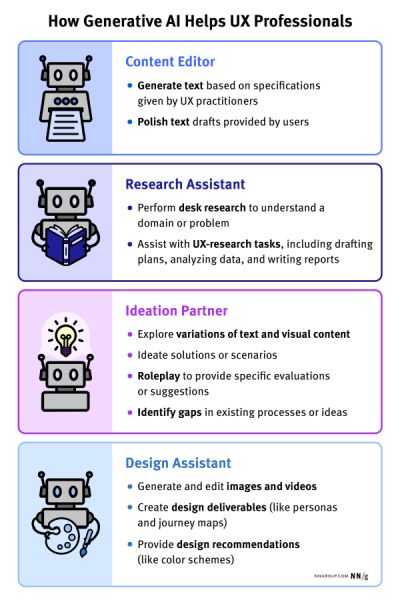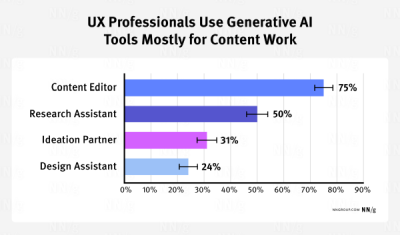AI & UX
Back to the future
I studied Psychology in the 1990s, specialising in Engineering Psychology and Cognitive Ergonomics. AI was still a hot topic (it started in the 1970s). We learned about neural networks, and everyone was dreaming about expert systems capturing all expert knowledge from domain experts like medical specialists. We studied LISP (created in 1960, Lisp is the second-oldest high-level programming language still in use after Fortran and was closely connected with the artificial intelligence research community); we started to use email and program websites. The MIT (Massachusetts Institute of Technology) was the Holy Grail. We watched CHI (Conference on Human Factors in Computing Systems) videos about innovative, futuristic product ideas.
And now, finally, computers' processing capacity and speed allow computers to emulate one of the critical abilities of humans: the ability to learn. Since the moment we are born, we learn and adapt to our environment. Continuous learning is also a vital skill for every employee. Computers are now severe competitors for us, as they can take over many tasks previously thought to be solved uniquely by humans.
Am I worried about my job as a user researcher?
No. :)
As stakeholder management and creating engagement of colleagues and users are the essential tasks of a user researcher, I am not worried AI will replace me.
UX and product development is a team sport. We need meetings in person, we need to share ideas, we need to brainstorm and ideate. The passion and energy necessary for product development is only possible between humans and in person. The Google people who created the new Chat GPT worked together in person in the office. Only because of that we enjoy the benefits of generative AI now. (ChatGPT is built upon generative pre-trained transformer (GPT) models developed by Google.)
What about AI in products?
There is such a buzz about AI that you would think you should build it into every product.
From a UX research point of view, we think about the value of a product for the user — regardless of what tools or features we are using. What job is the user trying to get done? AI is only a means to the goal of providing a valuable service to users. Just for the sake of using fancy new technology, it shouldn’t be used. A positive example of where AI is beneficial is customer support. Some studies even report that customers were happier with AI support than human support — it all depends on whether your problem is solved, whether you “get your job done”, regardless of how. That is why we at Stepstone use jobs-to-be-done as a guiding principle for our product development.
Will AI help to create more personalised product experiences?
AI has the potential to create much more personalised product experiences. Again, here we have to do our user research homework to find out what users need: some users have FOMO (fear of missing out) and don’t want too personalised content or features. At Stepstone, we use AI to give job seekers more relevant job recommendations. We have many AI products, both traditional AI and several new products with generative AI.
How does AI support my work as a user researcher?
AI can take over the more boring tasks of a user researcher — transcripts and extracting meaning from qualitative data. The amount of qualitative data you have to analyse can be challenging, from user interviews and surveys with open-ended questions, social listening data, or user reviews. AI is also useful as inspiration and support when creating questionnaires and interview guidelines. My colleagues have used Chat GPT to create copy texts for prototype testing. But when I asked Chat GPT about new ideas and themes for a planned meetup, I had to rely on my own ideas. It is handy for beginners in a field or to explore a new problem space. I was a mentor in a UX research course, and the survey questions Chat GPT produced were much better than those from the students. 🙂
A recent survey with over 800 UX professionals (AI as a UX Assistant, Feifei Liu, Mingjin Zhang, Raluca Budiu, 2023) shows that almost all respondents use generative AI tools regularly. Most use AI tools for both work and personal purposes. The most common type of activity is text content generation and editing.
Based on this survey, 30 types of tasks were identified for which UX professionals use generative AI and grouped into four roles: content editor, research assistant, ideation partner, and design assistant.

Reading about the complex tasks and problems for which the respondents use AI is fascinating. Everything is covered, from creating OKRs to user stories, a plan for a community of practice, literature reviews with extracting key points, summarising research, and creating presentation concepts. Many respondents reported starting a task by first exploring and learning more about the problem space with the help of AI, then using AI as a partner to ideate ideas and designs.
AI tools can speed up the design process immensely so that a prototype is ready to test with users within days.
The respondents in this survey were far more likely to use generative AI for text generation than for design tasks. The authors conclude: “Writing is an essential part of UX practitioners’ work, because UX is a communication-focused discipline.” In addition, AI text-generation tools are much more developed than multimedia-generation tools. Many UX tasks are currently too complex for AI tools.

Read the full article from the Nielsen Norman Group about this research.
AI tools for UX
Amol Kadam from Red Blue Blur Ideas gave an excellent overview of available AI tools for UX and how AI can support designers in their roles, presented at the World Usability Congress 2023:
UX Research
- Analysing user data: ResearchAI, MonkeyLearn, Lexalytics, Amplitude, Clarabridge
- Conducting user research: Crystal, crazyegg, Affectiva, realeyes, maze (AI-powered user research)
- Creating user personas: userpilot, SmarTone, PI — The Predictive Index, Receptiviti
UX Design
- Writing copy: AI-Writer, copy.ai, Writesonic, Shortly AI
- Creating logos: Looka, BrandCrowd, logoai, logomaster.ai
- Automating design workflows: brainpool.ai, Adobe Sensei, designify
- Creating user interfaces, websites, and mobile apps: Midjourney, DALL E, uizard
Amol Kadam doesn’t see these tools as a threat to designers; his understanding is:
“AI won’t replace the designer, but the designer with AI will replace the designer without AI.”
New research platforms are popping up every day, such as Outset.ai, a research platform offering AI-moderated interviews to speed up qualitative research.
Risks and caveats - the legal bits
There is a considerable risk that generative AI creates offensive, biased, or fake information. AI is fed by real-world information. Therefore, it can only replicate what is out there: the good and the bad, the truth and the lies. A lot of misinformation and potentially hurtful material is online. Creating a world consisting of the ultimate goodness and truth would be impossible. AI must find other ways to fight against the bad and the lies.
Another problem area is automated decision-making, e.g. in banking (decisions about credit) and government services (e.g., decisions about benefits). Automated decision-making is illegal: EU: The data protection law establishes that you have the right not to be subject to a decision based solely on automated means if the decision produces legal effects concerning you or significantly affects you in a similar way. AI can support decision-making but cannot replace human input entirely.
The question of ownership of created material is tricky. We had AI-created photographs of user segments from a clustering analysis, which was imposing how the emotions expressed in these pictures matched the clusters. But who owns these photographs? There is no author, no artist.
Users have to agree if their data are used to train AI models. New kind of consent forms are needed. We use consent forms in research to get users’ consent to keep their data (recordings, videos, photographs). But this is something else. It is essential to be transparent to the user about how AI is used and how their data is used.
Outlook
As a user researcher, I am very excited about AI because there are endless opportunities for great user experiences and exciting products.

